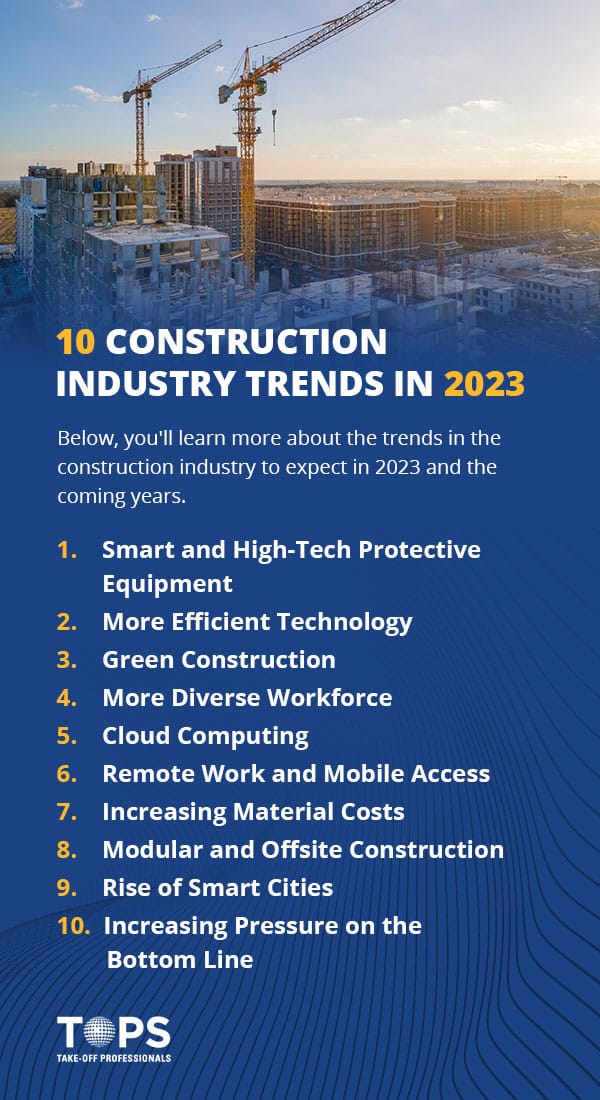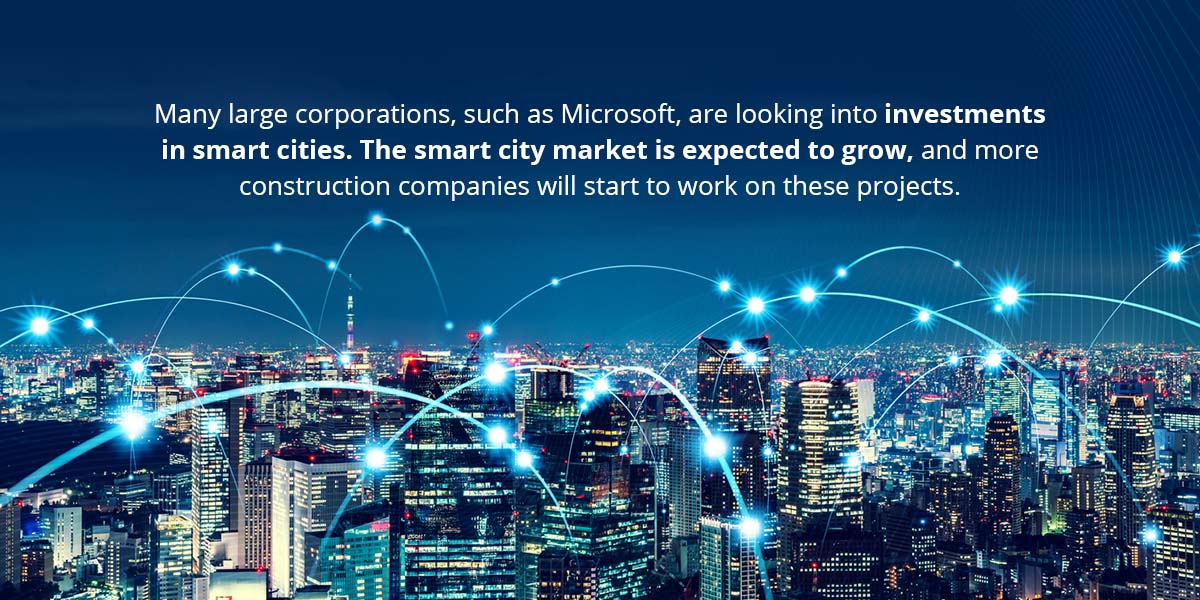Material and labor shortages, emerging technology, transportation delays and other factors have significantly impacted how the construction industry has operated in the last few years. Still, despite the turbulence the industry has experienced, the sector is expected to reach $14.4 trillion in 2030.
Companies can harness emerging construction trends to leverage the shifting market and overcome competition.

10 Construction Industry Trends in 2023
The construction industry is continuously evolving. Emerging technology trends are changing how companies perform different tasks. Explore the trends in the construction industry to expect in 2023 and the coming years.
1. Smart and High-Tech Protective Equipment
Site guidelines were changed to emphasize safety and cleanliness, largely due to COVID-19.
The industry also saw new machines that could identify and eliminate safety issues, such as wearable work boots that can connect to Wi-Fi and alert someone if a person has fallen. Environmental sensors are also gaining traction on construction sites. They help detect heat, winds and noise so workers know when to evacuate themselves and costly construction equipment during a weather event.
Steps are also being taken to incorporate robots on the job site to help improve safety. For example, many construction sites implement material-moving “mules” to transport heavy or hazardous materials to keep workers out of harm’s way. The construction industry also focuses on 3D printing to help reduce transportation risks. High-tech protective equipment will likely show up on more construction sites as more companies prioritize worker safety.
2. More Efficient Technology
New construction technology also aims to increase efficiency and productivity. In turn, it can streamline different processes to save valuable time and money. Examples of this technology you’ll likely see more of include:
- Construction drones: Drones in the construction industry are one of the most popular technological trends continuing in 2023. Drones are useful for construction projects, mapping large areas and providing real-time information that can help streamline processes and improve decision-making.
- Smart contracts: This technology helps organizations have a shared system to conduct business, enabling them to buy, track and pay for their services. Smart contracts are an all-in-one system that can help increase security, speed up closeouts, automate the supply chain and improve project tracking.
- Augmented reality (AR): AR is quickly becoming more popular within the construction industry, making it easier for project staging and allowing buyers and tenants to view tangible images before construction begins or in the middle of projects. AR technology can also enable construction companies to obtain automated measurements, train workers, and simulate structural or architectural changes quickly and affordably. AR in the construction industry is projected to reach $150 billion by 2030.
- Building information modeling (BIM): This technology helps construction companies improve their efficiency and stand out. BMI enables construction companies to create models of buildings and streamline the part prefabrication, improving the accuracy of builds. You can easily build and manage facilities and infrastructure through this technology, and there’s plenty of BIM software to consider. Over 98% of U.S. large architecture firms have employed BIM.
3. Green Construction
Green construction or building has become the new standard for renters, commercial tenants and homebuyers. As sustainability and ecotech become more mainstream in the next decade, costs for eco-friendly materials should start to decrease and become more commonplace.
Green construction refers to technology that can help reduce a building’s carbon footprint and the allocation of resources and building models to help reduce overall use. Renewable energy, such as solar, is becoming more popular among homebuyers and renters. This can increase costs for construction companies, as growing commodity prices have increased costs to produce solar panels, biofuels and wind turbines worldwide. Many eco-friendly features in a construction project are still considered investments, despite their long-term savings.
Another popular choice for urban areas is green scaping, which involves equipping rooftops with small parks and plants. These buildings are often built horizontally rather than vertically, which helps increase the available space for these green scapes.
Green scapes offer resistance against storms and provide natural insulation. A green roof stores water by the substrate. Water is then evaporated and returned to the atmosphere. As a result, the green scape reduces the amount of stormwater runoff, delaying the time the runoff occurs. In turn, it reduces stress on sewer systems at peak flow periods.
By increasing insulation, a green roof can decrease the amount of energy required to regulate building temperature — considering roofs are largely responsible for heat loss in winter and hot temperatures during summer.
4. More Diverse Workforce
One of the most notable trends continuing into 2023 is the increased demand for labor and a shortage of workers.
As a result, the construction industry is encouraging more women and Generation Zers to enter the workforce. There’s been a newfound shift in attitudes regarding trade schools, which enables construction companies to recruit more workers, boost their career growth and take advantage of new technology.

5. Cloud Computing
Cloud computing technology allows construction companies to store and access data on demand, making information retrieval simpler and more efficient. In 2023, you can expect the industry’s reliance on cloud computing to increase. This solution enables remote access to construction project data, streamlines collaboration and allows for easy data sharing.
6. Remote Work and Mobile Access
It doesn’t sound possible in the construction industry, but remote work is a growing trend. The COVID-19 pandemic caused many industries to switch to remote work, including construction. As a result, mobile access and remote work became more common within the industry. Research shows that 15%-20% of construction employees now spend their time on tasks that can be completed remotely.
Mobile applications now allow construction companies to offer worksite access like never before. Some apps can take accurate measurements using a smartphone camera, improve on-site accountability or offer real-time inspections. This technology was helpful during the pandemic, but as we’re starting to emerge from lockdowns and other restrictions, construction companies still use it.
7. Increasing Material Costs
When COVID-19 shutdowns first occurred, material costs rose due to limited availability, transportation delays and lockdowns in various countries. Building material costs have increased by 33% since the beginning of COVID-19.
Many countries still experience the effects of these situations. Labor shortages also make it more challenging to keep up with demand and are driving up wages. As a result, material prices are expected to continue increasing in 2023.
Technological innovations and materials can also contribute to increased costs, even though these are designed to save on costs in the future. Some of these materials include:
- Invisible solar cells
- Transparent aluminum
- Light-generating concrete
- Self-healing concrete
While it can be hard to predict precisely how material prices will fluctuate throughout the year, construction companies should anticipate some increases in material costs, especially as the United States continues to experience inflation throughout all sectors.
Many construction companies are shifting towards using new materials to reduce costs and improve sustainability. Some of the options available on the market currently include:
- 3D printed materials: 3D printing technology is revolutionizing the construction industry, helping companies create walls, floors, concrete and other building materials needed for construction.
- Recycled materials: Recyclable construction materials aren’t new to the industry, but they’re now being used to construct entire structures.
- Engineered Cementitious Composite (ECC): ECC is a bendable concrete with polymer fibers, making it more resilient than traditional concrete. ECC is more cost-effective for many construction companies and helps them decrease their carbon footprint, which is essential as more consumers become eco-conscious.
- Engineered timber: You can find different types of engineered timber on the market, created by arranging several types of softwood together. The result is a material product that has the strength to replace concrete and steel. Engineered timber can also help with lumber shortages. Limiting steel and concrete usage can help reduce emissions and lessen waste during material manufacturing.
8. Modular and Offsite Construction
Modular or offsite construction is constructing most of a building or structure before taking it to the construction site. These structures are assembled at another location for the construction company or the manufacturers before being taken to the site. The finishing touches are completed at the construction site.
New technology is helping the modular construction sector experience rapid growth, allowing construction companies to reduce their on-site construction. Offsite construction can also streamline construction projects, helping workers complete a quality build more quickly. You can save on material and shipping costs with modular construction, which can improve your bottom line.
This sector also experienced labor and material shortages like other construction companies. Despite these challenges, the popularity of modular construction continues to hold strong. Construction companies should expect to see more contractors utilizing modular construction services in 2023 and the coming years. The global offsite construction market was $72.11 billion in 2020. It’s expected to reach $114.78 billion by 2028.

9. Rise of Smart Cities
Many large corporations, such as Microsoft, are looking into investments in smart cities. These cities are more interconnected and intricate than traditional ones, requiring intensive planning and development before construction can begin. The smart city market is expected to grow to $6,965.02 billion by 2030, and more construction companies will start to work on these projects.
Some notable smart city projects include Hudson Yards in New York City, Masdar City in the United Arab Emirates and India’s Delhi-Mumbai Industrial Corridor. These projects are expected to improve modern infrastructure, environmental health and the economy.
Smart cities utilize information and communication technology to share information with the public, improve operational efficiency, and enhance government services and citizen livelihoods. Experts predict that 80% of people will live in cities by 2050, so there’s an increasing need for smart and sustainable cities.
Some roles the construction industry will take to improve the sustainability of these cities include:
- Installing “smart roads” to help reduce emissions and fuel costs.
- Making waste management changes, including smart bins and data collection to improve garbage collection.
- Adjusting public transportation using sensors and real-time data to detect high passenger volumes and traffic accidents.
- Measuring noise levels, air quality and energy with sensors.
Construction companies can prepare for these innovations by understanding the necessary skills and equipment to construct smart cities and planning for the government’s response to this shift.
10. Increasing Pressure on the Bottom Line
While construction revenue has been increasing in recent months, many companies still see slim net profits, leaving little room for unplanned expenses. On top of challenges with profits, construction materials and inflation are also affecting construction companies’ bottom lines. As a result, construction companies are looking for ways to be more profitable.
Construction companies can work toward this in different ways, including negotiating with suppliers or automating parts of the workforce. Construction companies must prioritize cost-savings and efficiency to help them increase their profits. You’ll also want to consider how the fluctuating cost of materials will affect:
- Bids.
- Sales goals.
- Quotes and estimates.
- Available funds and budgets.
Request a Quote From Our Experts
Take Off Professionals (TOPS) can help you utilize technology to keep up with emerging trends and revolutionize your construction projects. We offer various machine control data and preparation services, including:
Our data modeling services focus on your projects, allowing you to improve their performance from start to finish.
We can work with you on various levels, making it easy for you to reduce or increase our participation in your projects to fit your needs. If you want to be more accurate with your data, contact us today for a quote from one of our experts.


